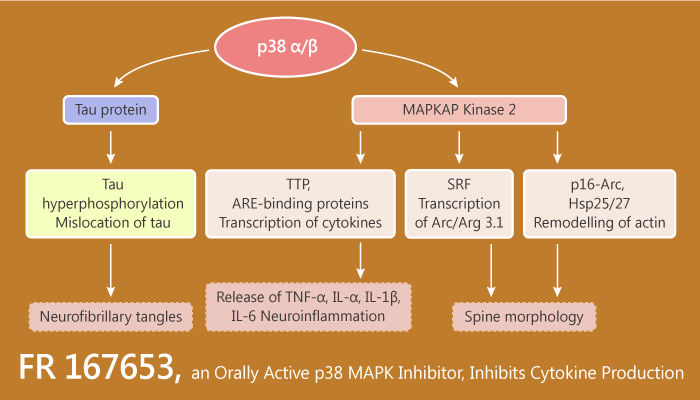Various types of cytokinesuchemokines react with their receptors. They transduce extracellular signals into intracellular response through a mitogen-activated protein kinase (MAPK) signalling cascade. Furthermore, p38 MAPK signalling might play an important role in the recruitment and activation of leukocytes via upregulation of various types of chemoattractant protein and adhesion molecules. on the other hand, in mesangial and endothelial cells, IL-1β and TNF-α upregulate MCP-1 expression through a p38 MAPK signalling cascad. However, it dose not know the precise roles of p38 MAPK on the inflammatory processes. FR 167653 ameliorates ischaemia/reperfusion injury in lung, liver, small intestine and heart via the simultaneous reduction of IL-1β and TNF-α.
FR 167653 is a selective p38 MAPK inhibitor, which inhibits the activation of p38 MAPK by suppressing the phosphorylation of p38 MAPK. In addition, FR 167653 is effective in treating inflammation, relieving trauma and ischemia-reperfusion injury in vivo.

FR 167653 markedly diminishes MCP-1 and RANTES transcripts in cultured human tubular epithelial cells. Moreover, FR 167653 decreases the number of infifiltrated cells at 4 h, 24 h,and 48 h after ischaemia/reperfusion. FR 167653-treated mice has a significantly decreases number of infifiltrated polymorphonuclear cells and macrophages 24 h after reperfusion. Furthermore, FR 167653 significantly decreases the extent of acute tubular necrosis. FR 167653 dramatically reduces phosphorylated p38 MAPK-positive cells in ischaemia/reperfusion kidneys. In addition, FR 167653 dose-dependently inhibites activation of p38 and has an ameliorating effect on cirrhosis formation. Significant dose-dependent reduction in a-smooth muscle actin immunostaining and hydroxyproline content of the liver was noticed in the FR 167653-treated rats.
All in all, FR 167653, a small molecule p38 MAPK inhibitor, which suppresses the production of TNF-α and interleukin-1β (IL-1β). FR 167653 markedly ameliorates renal ischaemia/reperfusion injury, possibly by inhibiting cytokineuchemokine expression and consequent phosphorylation of p38 MAPK in renal tissue.
Reference:
Furuichi K, et al.Nephrol Dial Transplant. 2002 Mar;17(3):399-407.